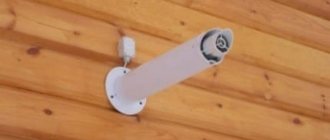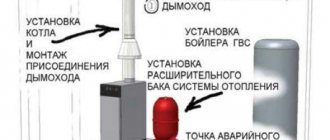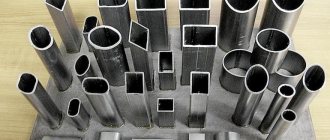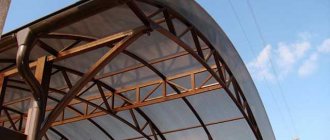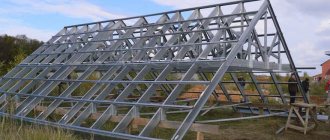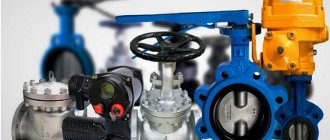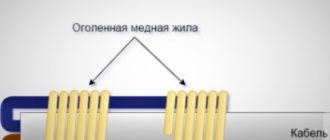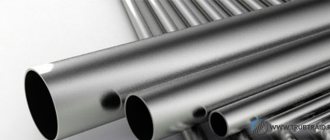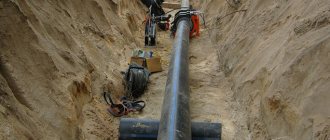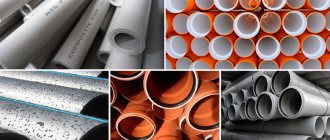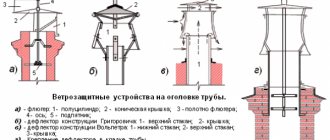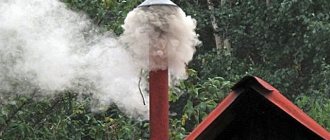Hello, my dear interlocutor.
More than one and a half million people die from carbon monoxide poisoning every year. And in most cases this happens due to faulty geysers or poorly cleaned air ducts.
Do you know what is most dangerous? The gas in cookers is specially “flavoured”. Therefore, our sense of smell can sense a methane leak. With gas in the column, the story is a little different. With poor ventilation, combustion occurs with a lack of oxygen, resulting in the formation of dangerous carbon monoxide, after inhaling which a person loses consciousness and falls asleep. Unfortunately forever.
Therefore, a hood for a geyser is a must-have device. We’ll find out how it works and how to install it correctly from today’s article.
Why does a gas water heater need a hood?
A geyser is a convenient device that allows you to provide residents of your home with hot water at any time of the year. Modern devices are equipped with temperature regulators, sensors for the operation of the water point and other convenient functions. But even the most modern unit will not protect against carbon monoxide if the chimneys in the house are not cleaned.
In addition, household gas is explosive, and if leaked, in a certain proportion with oxygen, it can provoke a disaster.
A hood will help solve the issue of removing combustion products and providing sufficiently high draft. It should be installed strictly in accordance with the requirements of regulatory documents.
The chimney of the column should not be confused with devices for other kitchen appliances that run on gas.
We will consider the advantages of built-in coal hoods for kitchen stoves in one of the following articles.
Requirements for chimneys for geysers (SNIP)
Requirements for chimneys are set out in the following documents:
- SNiP 41-01-2003 in a new edition (SP 60.13330.2012);
- NPB 252-98 (fire safety standards);
- SP 42-101-2003;
- VDPO (rules for the production of pipe and furnace works).
The main provisions regarding the direct removal of smoke from household water heaters are collected in the following paragraphs:
- The cross-sectional area of the chimney pipe must be greater than or equal to the cross-section of the outlet pipe of the column;
- Laying gas pipes through living rooms is prohibited;
- The chimney system must be completely sealed, resistant to corrosion and temperatures up to 200°C;
- The vertical section of the chimney at the outlet of the column should not be shorter than 500mm. Only in some cases this figure is reduced to 250mm;
- The length of connecting pipes should not be more than 3 m in designed houses and no more than 6 m in existing ones;
- The design allows for no more than 3 turns with a radius of at least the pipe diameter;
- If the wall of the building is made of non-combustible materials, the distance from it to the exhaust pipe must be at least 5 cm, if the wall material is flammable - at least 25 cm. If the fire protection requirements of SP 42-101-2003 are met, the distance can be reduced to 10 cm;
- If the connecting pipe passes through an unheated room, it must be protected with thermal insulation;
- The slope of the exhaust pipe towards the column must be more than 0.01;
- You cannot use one hood for a gas water heater and a gas stove;
- The ceiling height in the room with a water heater and chimney should not be less than 2 m. Area – at least 7.5 m for one device, at least 13.5 for 2 devices.
Calculation of hood parameters
Before starting work on installing a chimney for a geyser in an apartment or private house, it is necessary to calculate the parameters of the exhaust channel. These parameters determine the required amount of air removed from the room.
When calculating, the following indicators should be taken into account:
- power of heating devices;
- volume of exhaust gases;
- difference in temperatures of outside air and combustion products;
- the height of the chimney pipe (for gas installations at least 2 m).
There are many types of pipelines for geysers, of different diameters, shapes, and lengths. Standard chimney diameters are 110-130 mm. For dispenser power up to 19 kW, a pipe with a diameter of 11 cm is used, above – 13 cm.
Criteria and rules
SNiP standards, fire safety criteria and other rules prohibit the combination of a column and a chimney. As a result, the functionality of ventilation is seriously reduced. Also often in such situations, negative consequences affect the gas apparatus itself. For example, it may go out during operation; its wicks do not light up. It often makes unpleasant noises.
The reason lies in the operation of the traction indicator. And he, in turn, acted due to the presence of a hood and a gas water heater in the same room.
The main threat of such a combination is the risk of carbon monoxide entering the room. It is directed from the column. And the hood, with its draft, throws it away from the functioning gas apparatus. As a result, the room is filled with dangerous gas.
The risk is especially great if the windows are still closed. Then there is no natural ventilation. And both the residents of a particular apartment and their neighbors are at risk. True, only neighbors on the upper floors can suffer.
If you live on the top floor of the house, then you only put yourself and your household at risk.
If you find that some owners have a heater and an extractor hood installed at the same time in the kitchen, report it immediately. You can apply to the city or regional gas organization.
What kind of corrugation is used for chimneys
Combustion products in an apartment building are discharged into the ventilation duct, in a private apartment - to the street. Depending on where the gases are discharged, the pipes are divided as follows:
- Coaxial - the pipe exits through the wall or roof of the house to the street;
It is a structure of two pipes, the larger of which is put on the smaller one. Oxygen from the street is supplied to the fire through the free space between the pipes.
- Chimney - with connection to the ventilation duct.
Chimney pipes, in turn, can be smooth steel or corrugated.
- Smooth steel pipelines. Covered with white heat-resistant enamel or galvanized. Maximum length -1.5m. Made from sheet steel with a minimum thickness of 0.6mm. Due to temperature differences, condensation forms in the pipes and freezes in winter. Therefore, the structure must be carefully insulated.
- Flexible corrugated air ducts. Corrugated pipes are the best choice for removing waste gases from the column. They are convenient, reliable, and inexpensive. Due to their low weight and flexibility, they are easy to install.
The standard diameter of corrugated pipes is 11 and 13 cm. Maximum length – up to 3m. If you need to mount a longer section, the parts are connected with metallized tape. It can also be used when repairing corrugation.
When choosing a pipe for exhaust, it is necessary to take into account the temperature of the exhaust gases. Usually in the column it reaches 200-300°C, so the operating temperature of the corrugation should be at least 350°C.
Corrugated chimneys are made from stainless steel or aluminum.
In the case of gases venting through the wall, a special hole is prepared in it with an installed passage pipe, isolating the wall and the pipe from each other.
Let's look at the features of each material.
Stainless steel chimney:
- Withstands heating up to 900°C.
- Stainless steel is a durable and corrosion-resistant material;
- The corrugation bends in any direction and does not require additional fittings.
Aluminum:
- The multilayer structure made of aluminum foil and reinforcing wire is not inferior in flexibility to stainless corrugation;
- The temperature of the exhaust gases should not exceed 400° C;
- Aluminum is lighter than stainless steel and has better stretchability;
- These products are inferior to their stainless steel counterparts in strength.
The use of aluminum pipes is not prohibited, but, as practice shows, inspectors in most cases require replacing aluminum with another material.
In any case, you should purchase only certified products.
Installation work
Pros of a qualified installation:
- High-quality and safe smoke removal;
- Increasing the efficiency of equipment operation;
- Protection against accident and leakage.
- A section of pipe is being installed into the wall. After that, the structure is connected to the column and connected to a section of pipe for output to the street. All cracks and connections are sealed with sealant;
- A smoke exhaust duct is installed on the outer wall. All connections are secured with clamps;
- To ensure that the device is level and stable, it is additionally secured with spider fasteners at a distance of two meters. It is important that there are no deflections in the system;
- To prevent clogging of the system, a protective umbrella is placed on top;
- It is necessary to organize a window below to inspect the condition of the chimney.
As soon as the work is completed, it is necessary to check the traction force. To do this, you need to bring a burning match to the ventilation or chimney opening. If the flame deviates, it means there is draft.
Why doesn't the system stop working?
Problems that may appear in the operation of the chimney and why they appear:
- Burnout: poor installation, use of low quality materials;
- Soot fire: poor operation of equipment, failure to follow instructions;
- A considerable amount of condensate: insufficient insulation of the system.
In the organization and installation of gas equipment, everything must be clear. You can turn to professionals - now you know how to check their work.
Average prices per set
The average cost of the kit primarily depends on the length of the chimney and the diameter of the selected pipe.
When purchasing, please note that aluminum corrugation stretches from the original length of 0.65cm to 3m. Stainless steel products have little stretch. Average cost of products:
- Aluminum - 200 rub/m;
- Stainless steel sleeve – 650 rub/m.
In addition, you should purchase special metal tape, sealants and the necessary fittings.
The average cost of a complete set made of aluminum is 500 rubles, from stainless steel - 1000 rubles.
How to install
The installation of gas equipment should be carried out by a specialist. If you decide to install the pipe yourself, be sure to read all the safety requirements.
Procedure:
- We accurately measure the distance required to install the chimney and apply markings to the wall;
- Purchases clamps for fastening, pipes, an adapter from the column, units for laying pipes through ceilings, a nozzle for covering the street chimney;
- We determine where the pipe will go - into the ventilation duct shaft, or to the street, and prepare the appropriate technological holes;
- We begin the installation of the lower part of the chimney - connect it to the column;
- We connect a pipe with a valve to increase traction;
- We fasten the remaining parts of the chimney with clamps installed every 1.6 m;
- All locations of passages through the floors and roof must be isolated with plugs to prevent fires;
- If the room does not have an exhaust duct inside the wall, it is recommended to use an attachment or root pipe for a gas water heater;
- If steel pipes are attached, it is necessary to provide L-shaped adapters for the ventilation duct and exhaust hood;
- All joints are connected using heat-resistant sealants;
Advice from a professional: To install a hood in a private house, it is better to use coaxial pipes or double sandwich pipes with insulation. In an apartment building, you should not install a chimney yourself at all.
Step-by-step instructions for constructing a smoke exhaust system
When commissioning the equipment, room ventilation must be taken into account. In the absence of air exchange, forced turbo exhaust must be installed. Without it, putting a gas boiler into operation is impossible. We will look at how to install a hood for a gas boiler in a private house using the example of a coaxial chimney. The length of the pipe from the boiler room to the street for this type of hood cannot be more than two meters.
- When starting work, make sure that the installation of the gas boiler complies with the rules and regulations approved by inspection organizations in order to avoid reworking the entire power unit.
- Select the appropriate material for the hood, taking into account the parameters of the gas outlet: gas boiler inlet = pipe diameter.
- Calculating the power of the fans and their number, taking into account how long the hood is, the number of bends in its structure, and the position in space relative to the horizon, at what height the exhaust pipe is located in the room.
- Do not forget about the features of budget equipment indicated in the technical passport.
- All materials used in the work must be fireproof and not susceptible to corrosion.
- After making sure that all parts are intact, we proceed to assembly. We connect the chimney elbow to the gas boiler pipe using a tee.
- To extend the coaxial pipe and connect all its parts, special crimp clamps and fire-resistant sealants are used.
- Turbo exhaust is used if there are more than two elbows in the pipeline geometry. This helps maintain the efficiency of the gas boiler . The fan and all sensors are installed after installing the supply pipe.
- Installing a coaxial pipe outside a building is no different from installing a conventional sandwich chimney.
Outside the building
Having laid the line for the exhaust device in the house, the design of the hood for the gas boiler goes outside.
- As soon as the pipe has been brought outside through a hole in the wall, it must be closed with special metal plates. The remaining space between the pipe and the wall is filled with mineral wool.
- Now we install the tee. The lower hole is closed with a plug with an inspection for cleaning the pipe.
- We increase the chimney to the required length by connecting the parts using a special sealant and clamps with gaskets. As the pipe grows, we attach it to special brackets.
- We install a protective cone at the top of the chimney and additionally attach it to guy wires in those places.
- If the chimney structure was not coated with special paint at the factory, this can be done at home. This is done to protect the metal from environmental influences.
When ordering an outdoor chimney system, it is important to consider where the forced exhaust starts from the gas boiler or from the room where the turbo elements are installed.
Inside the house
Inside the house, the installation of a coaxial chimney was described in detail, with comments, above. The only step you have left to do is to connect two pipes, street and indoor, using the extension method. For additional insulation, it is recommended to use special metal tape.
I would like to note an important advantage of a coaxial chimney - the absence of additional holes in the roof or wall of your home.
Common mistakes
Errors when installing ventilation elements can lead to disruption of the proper operation of the structure and loss of operational safety. The most common are the following:
- Combination of hoods for a water heater and a gas stove, or for a gas boiler. In this case, reverse draft may occur in the ventilation shaft and carbon monoxide will return to the room;
- Do not connect two speakers to one chimney;
- The next mistake concerns the installation of a geyser - it is often placed in the bathroom, this cannot be done. All gas appliances must be installed in rooms with a window;
- Self-taught craftsmen often confuse the ventilation duct with the riser supplying water to the column. The consequences of such an error will be the replacement of all gas equipment, not only for you, but also for your neighbors below. Gas services remove liquid. They will turn off the gas and issue a hefty fine;
Ventilation criteria
They are reflected in building regulations. In standard houses, ventilation ducts pass 150-180 cubic meters per hour. air.
Many hoods produce 600-1100 cubic meters during the same interval.
The standard concerns two types of ventilation: natural and mechanical. For the first, the standard is three times the volume of air. For the second – 10-12 times.
The hood is not a second type of ventilation, as many sellers claim. It does not perform a ventilation function at all. Its main task is to eliminate polluted air in one zone - above the stove.
And the hood takes in air only at a distance that is identical to its suction hole. And it emits air with a value of 15 of these diameters.
Therefore, the hood does not take air above its position. It only takes the one that is under and next to it.
